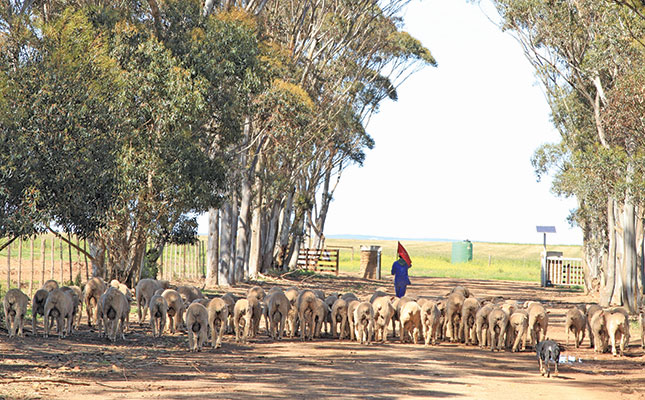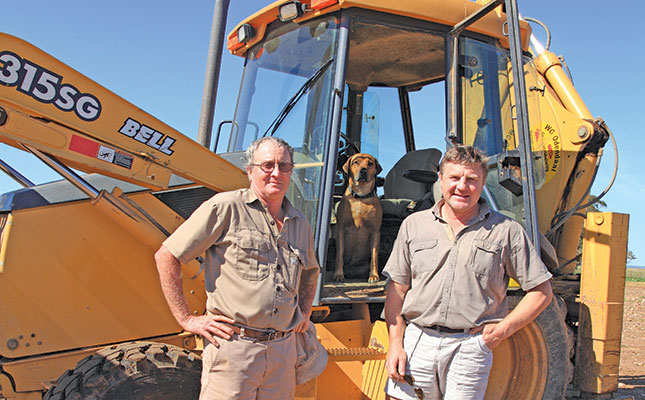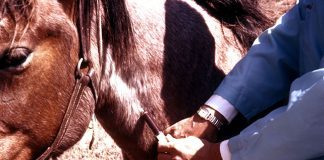
Photo: Glenneis Kriel
At Pienaarsrivier, a grain and sheep farm near Riversdale in the Southern Cape, farm owner Kobus Horne and his sheep production manager, Dirk Liebenberg, have significantly improved production efficiency and reduced costs through their use of technology and a carefully planned management system.
One of the most noticeable features of the farm is the careful way in which the production facilities have been positioned and structured for the animals’ comfort and for ease of movement and management.

The handling facility, shearing shed, feedlot, lambing shed, feed mill and camps for rams, in-lamb ewes, and ewes with lambs are all set within a radius of a few hundred metres.
Computerised scale system
At the handling facility, which is set out in the shape of a wagon wheel, Liebenberg and his team use a computerised scale that sorts the animals into one of five pens based on pre-programmed instructions.
The animals are sorted primarily according to weight, and the ewes are separated according to the number of lambs they are carrying. The computer identifies the animals by reading their radio frequency identity tags, which are attached to their ears when they are two days old.
“Where we used to take at least six hours to weigh and sort 1 200 sheep, we’re now able to do so in less than two hours,” says Liebenberg.
The technology also allows for better utilisation of labour and enables Liebenberg and his team to monitor the growth of feedlot animals more carefully.
“Animals in the feedlot are weighed weekly and sold as soon as they weigh 48kg. We also sell those that aren’t picking up weight anymore, as we can’t afford to keep freeloaders.”
Management
The farm has three production groups, each comprising 1 200 Merino ewes. The ewes lamb every nine months, in January, October, April or July depending on the group’s production cycle.
Each group is divided into four subgroups, each of 300 ewes, to spread the lambing season over the month. The aim, says Liebenberg, is to obtain new lambs every second week, stretched over six weeks.
The farm boasts a weaning percentage of 140% per season, but having four lambing cycles in three years pushes the weaning percentage up to an impressive 180% per year. This translates into 1 800 lambs for every 1 000 ewes that reproduce each year, as opposed to 1 400 if there were only one lambing season a year.
The ewes are synchronised for breeding when their lambs are weaned at 100 days old, with first-timers being included in the group once they reach 48kg. The farm’s top-performing animals, making up one of the four subgroups, are superovulated for laparoscopic insemination with semen from two rams bought in for the purpose.
“The idea with the top subgroup is to improve the farm’s genetic stock. The selection of rams to use on the group will therefore be based on specific traits that we might want to improve,” says Liebenberg.
The other three subgroups are placed with teaser rams before being serviced by the fertile rams.
A ratio of one ram for every five ewes is used and they are run together for just three days. Two weeks later, the ewes are placed for 17 days with Dormer rams, which service those ewes that failed to conceive with the first breeding attempt.
The ewes are scanned 35 days later to ascertain the number of lambs they are carrying and, based on the size of the foetuses, whether these are Dormer hybrids. Ewes that are still not in lamb are sold the next day.
“The system can’t accommodate ewes that don’t conceive, as we work with too many sheep. We produce around 700 ewes with each breeding cycle, of which 200 will have to be culled,” explains Liebenberg.
The 120 rams used for breeding are subjected to fertility tests every six months to ensure they can perform. Most of the ewes and breeding rams are kept until they are five years old, after which they are sold, irrespective of their productive performance.
Lambing house
Three weeks before the lambing season starts, ewes are sorted according to the number of lambs they are carrying.
They are thereafter kept in large camps near the lambing facility, and fed ad lib so that they are well able to look after their lambs and regain condition rapidly afterwards. Taking the ewes off the veld and feeding them pellets also helps prepare them for the feed they will receive in the lambing pens.
They are moved into pens in the lambing house the day before they are due to lamb.
“The ewes carrying multiples usually lamb earlier than those carrying singletons, with the time of lambing ranging from 145 to 150 days after being serviced,” says Liebenberg.
Birth data, such as date of birth and number of lambs, is recorded on a white card attached to each lambing pen, to be incorporated into the rest of the farm’s production records.
Each lamb receives an energy booster within 12 hours after birth, and their navels are treated with iodine to prevent infection. Two days later, RFID tags are attached to their ears and they receive another energy booster.
Singletons (along with their ewes) are removed from the pens when they are four days old. Liebenberg and his team carefully monitor the growth of twins and higher multiples before releasing them in order to ensure they are strong enough to cope outside.
The lambing facility is thoroughly cleaned between entries to prevent a build-up of parasites and diseases.
In addition, the bedding, comprising straw, shavings and sheep manure, is collected after each batch of animals leaves the pens, and added to material collected from the feedlot to make compost. This is spread over the farm’s wheat lands to boost soil health and structure before planting.
Larger camps
Once they leave the facility, the ewes and their lambs are moved to a series of camps of increasing size at three-day intervals to ensure strong bonding and to identify potential problems.
During the first stage, the ewes and their lambs are kept in small camps, at five ewes plus their lambs per camp, alongside the lambing shed.
They are then merged into groups of 10 in slightly larger camps behind the small camps, and thereafter to even larger camps at a stocking rate of 20 ewes plus lambs per camp. Finally, they are moved to the largest camps, each of which holds 40 ewes and their lambs.
Creep feed is introduced at the last camp. Although the lambs consume little of this at first, it helps them get used to the pellets and eases the transition from milk to solids when they are weaned, according to Liebenberg.
When the lambs are 21 days old, they and their ewes are moved onto pastures or veld on the rest of the farm. At 45 days, the lambs are tattooed and their tails docked to prevent blowfly problems. They are also dewormed and given a multivitamin product at the same time.
At 70 days, they receive an inoculate against the major diseases prevalent in the region, anti-parasitic medication and a multivitamin and mineral supplement. The ram lambs also receive a product that stimulates their appetite, helping to accelerate growth.
When they are 100 days old, the lambs are once again dosed, inoculated, and given multivitamins and minerals.
Selection
The Merino lambs are weaned at the age of 100 days, and the hybrids at 75, as hybrid vigour results in accelerated growth. The ram lambs and hybrid ewe lambs are then moved to the feedlot, close to the sorting camp.
An expert contractor then helps to physically evaluate the build and fleece quality of the ram lambs produced by laparoscopic insemination. The top rams are kept for the farm, and the rest sold to other farmers.
Liebenberg says that they are planning to select only polled rams in future to prevent accidental injuries.
The remaining animals are finished in the feedlot. Here they are fed ad lib, with the troughs being refilled automatically under the control of a smart auger system that senses the amount of feed left. They are sold once they reach 48kg, with the first animals usually market-ready within two weeks.
Shearing
The sheep are sheared twice a year, in February and August. “The farm is too busy to shear at other times, as we have to plant in April and harvest from October,” says Liebenberg.
Shearing represents about 40% of the income from sheep, and lamb sales the remainder.
The goal is to produce fibre with a diameter of 18 to 20 microns, but this has to be balanced with the volumes of fleece produced.
“We aim for at least 5kg to 6kg of wool per sheep, ewes and lambs included,” says Liebenberg.
He adds that the feed influences the thickness of the wool, with sheep on good-quality lucerne producing a stronger fibre, and those on poorer-quality feed producing finer wool.
Liebenberg explains that Pienaarsrivier’s intensive sheep management system, which requires considerable planning and management, was not thought out overnight, but grew systematically out of lessons learnt over the years.
“Having to switch to a system like ours would be overwhelming if you had to change everything in a short time, but we’ve refined our system over time so that it works for us. Today, it‘s embedded in the way we do things, almost like second nature.”
Email Kobus Horne at [email protected].











